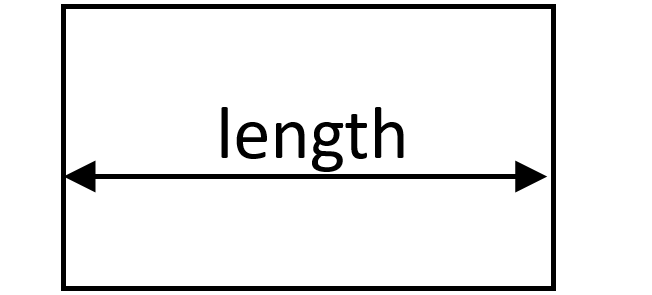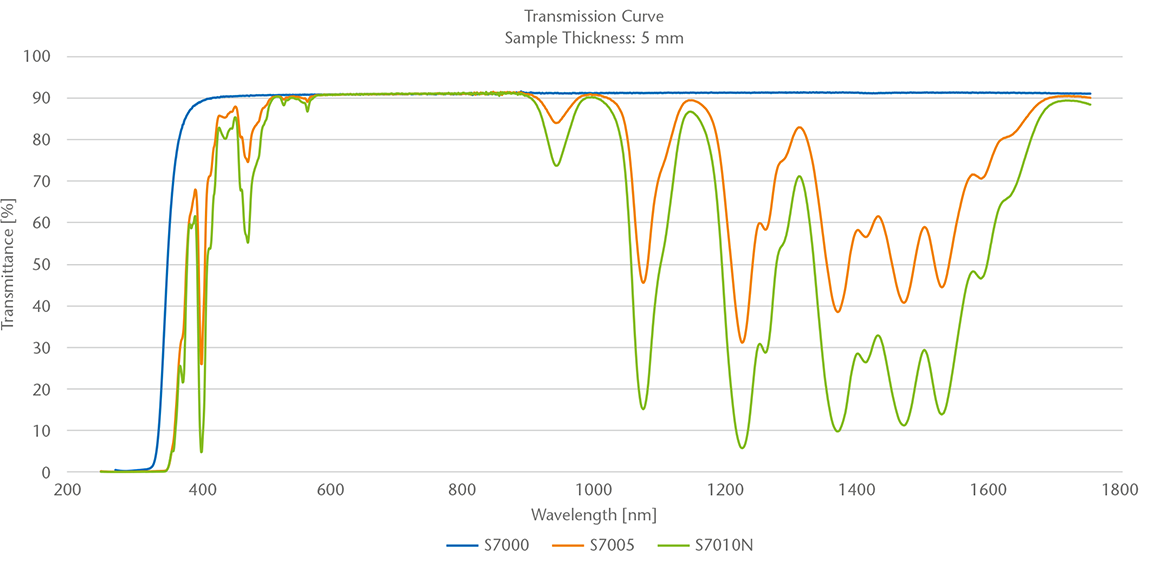Technical Details of Optical Filter Glass
Vast range of properties for a vast range of functions
Optical Properties
Filter glasses modify the spectrum of light
Filter glasses are made for their selective absorption properties that modify the spectrum of any radiation.
The glasses are specially developed and optimized for their optical effect on the electromagnetic spectrum.
Our portfolio glasses can be sorted by their function into the following groups:
Internal transmittance of SCHOTT filter glasses
Forms of Supply
Positive list
Our portfolio glasses are melted regularly and have long-term availability. These glasses will remain in our portfolio for at least the next five years. Our positive list is available in the download section.
Matte plates
Most of the glass types can be purchased as a matte plate in the standard format 165 mm x 165 mm x 4 mm.
Polished filters - Dimensions and surfaces
Our filter glasses are melted and cast, with the final components varying in shape and thickness. We also produce polished filters according to your specification.
We offer polished filters in different dimensions and in optical surface quality. Specifications of polished surfaces depend on the geometry (thickness, size, shape, effective area) of the filter.
Rectangular shape

Disc shape

Other shapes and sizes upon request.
For more information about dimensional tolerances and surface quality, please refer to the ‘Optical Filter Glass Catalog’ in the download section (Part II – Properties - 5.1 Dimensions and 5.2 Polished surfaces).
Chemical Properties
For various chemical requirements, especially during different processing steps, we use the resistance classes that apply to optical glass. The greater the resistance of the glass, the lower the class number. Specifications on physical and chemical properties for the SCHOTT Optical Filter Glass range (for reference only) are available in the ‘Optical Filter Glass Catalog’ in the download section (Part II – Properties – 3 Optical filter glass: reference values).
Stain resistance
The test procedure for stain resistance provides information on possible changes in the glass surface (stain formation) under the influence of slightly acidic water (for example perspiration, acidic condensates) without vaporization. The classification of optical filter glasses into stain resistance classes FR 0–5 is available in the ‘Optical Filter Glass Catalog’ in the download section (Part I – Description - 5.1 Stain resistance).
Acid resistance
Acid resistance according to ISO 8424 classifies the behavior of glass surfaces that come in contact with large quantities of acidic solutions (from a practical standpoint for example, perspiration, laminating substances, carbonated water, etc.). The classification of optical filter glasses into acid resistance classes SR 1–53 (ISO 8424) is available in the ‘Optical Filter Glass Catalog’ in the download section (Part I – Description - 5.2 Acid resistance).
Alkali resistance
Alkali resistance according to ISO 10629 indicates the sensitivity of optical filter glasses in contact with warm alkaline liquids, such as cooling liquids in grinding and polishing processes. The classification of optical filter glasses into alkali resistance classes AR 1–4 (ISO 10629) is available in the ‘Optical Filter Glass Catalog’ in the download section (Part I – Description - 5.3 Alkali resistance).
Solarization
Solarization comes from prolonged exposure to intense light sources with high UV radiation, which can cause permanent reductions in the transmission of optical filter glasses. Solarization is mainly a function of the intensity and spectral distribution of the radiation – the shorter the radiation wavelength, the higher the solarization.
Humidity resistance
After a certain amount of time, the surfaces of highly sensitive glasses can exhibit a slightly cloudy residue. Initially, this residue can be removed using glass polishing compounds. However, more severe attacks caused by warm humidity can ruin the surface polish quality.
With humidity resistance, color filter glasses can be classified into four groups. These four groups are marked in Table 3: Physical and chemical properties (for reference only) in our ‘Optical Filter Glass Catalog’ (page 61):
Group “resistant glasses”
- No substantial surface change occurs in most of the optical filter glass types. A change in the surface is only possible under extreme conditions, such as 85 °C and 85 % relative humidity for hundreds of hours.
Group “robust glasses”
- Glass types withstand warm humidity testing at 60 °C and 90 % relative humidity for more than 48 hours.
- Glass types marked with a closed umbrella
Group “sensitive glasses”
- Glass types should be used and stored in a moderate climate or in closed work and store rooms (constant temperature below 35 °C, relative humidity less than 60 %). A desiccant is to be used when wetness is a possibility. For use and storage in open air and tropical climates, it is advisable to apply protective coatings which SCHOTT can provide upon request.
- Glass types marked with an opened umbrella
Group “delicate glasses”
- For this optical filter glass types, changes in the glass surface are possible after several months of normal storage. These glasses are to be handled with care: Any contact with water or warm humidity should be avoided. A desiccant is to be used for long-term storage of unprotected glass. For this reason, protective coatings are recommended which SCHOTT can provide upon request.
- Glass types marked with two opened umbrellas
Laser Cavity Filter Glasses S7000, S7005 and S7010N
SCHOTT produces three types of laser cavity filter glasses:
- S7000 is a clear, cerium-doped glass usable as laser cavity material. It is also available to serve as a cut-off material.
- S7005 is a laser cavity material with 5% doping of samarium oxide (Sm2O3), and is typically used for tube walls thicker than 6 mm.
- S7010N is a laser cavity material with 10% doping of samarium oxide. This glass is recommended for most applications.
SCHOTT offers a complete line of these commercial silicate filter glasses and can produce a full range of doping levels for specific applications.
For specifications please view our ‘Laser Cavity Flow Tubes & Filter Glasses Datasheet’ in the download section.


